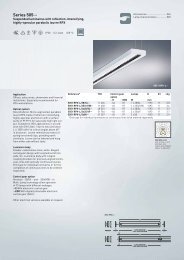TRILUX Luminaires - Proljus AB
TRILUX Luminaires - Proljus AB
TRILUX Luminaires - Proljus AB
Create successful ePaper yourself
Turn your PDF publications into a flip-book with our unique Google optimized e-Paper software.
Calculations<br />
The necessary object luminance depends<br />
on the ambient brightness (Table 1.26).<br />
Most illuminated objects have matt surfaces<br />
so the illuminance E (in Ix) can be calculated<br />
from the luminance L (in cd/m 2 ) and the reflectance<br />
value ◊ of the surface based on the<br />
following formula:<br />
L = ◊ · E / π<br />
If the reflectance value of the surface is<br />
known or determined by comparing with<br />
surfaces of known reflectance values, the<br />
maintenance value of the mean illuminance<br />
on the surface to be illuminated can be calculated<br />
according to the following formula:<br />
E = L · π / ◊<br />
Reflectance values of typical building<br />
materials of illuminated objects are listed<br />
in Table 1.27.<br />
Optical systems and their effect<br />
(taking Lumena as an example)<br />
In case of facades with prominent projections,<br />
e.g. balconies, bays, balustrades, etc.,<br />
the spotlights should be positioned with<br />
large intervals in order to prevent significant<br />
cast shadows. Otherwise additional spotlights<br />
are to be provided for illuminating and<br />
accentuating the shady areas – if need be<br />
with a different light colour.<br />
In case of reflective facades, e.g. glazed surfaces,<br />
the spotlights must be installed below<br />
eye level in order to eliminate any reflections<br />
(reflex glare). In case of aluminium facades<br />
with significantly aligned reflection behaviour,<br />
this arrangement would result in a dark<br />
surface, because the light of the spotlights<br />
is reflected upwards. Here, the spotlights<br />
should be installed at a greater height so<br />
C90<br />
CO<br />
C18O<br />
C270<br />
Reflector RE<br />
rotationally symmetrical narrowangle<br />
light distribution.<br />
C90<br />
Brightness<br />
Luminance on the<br />
of environment<br />
illuminated surface<br />
Less, in free environment 3 up to 6.5 cd/m2 Less, in developed dark environment 6.5 up to 10 cd/m2 Medium, in developed medium-bright environment 10 up to 13 cd/m2 High, in bright environment 13 up to 16 cd/m2 1.26 Guideline values for luminance on illuminated surfaces.<br />
that there is no glare reflection at the main<br />
viewing position.<br />
Trees are illuminated either from far away<br />
or from the treetop in order to be able to<br />
perceive the foliage and the entire plant.<br />
Alternatively, ground-level spotlights close to<br />
the tree trunk are common for illuminating<br />
the crown of the tree from below. In this<br />
case, light sources with a significant green<br />
component in spectrum are recommended,<br />
e.g. metal halide lamps, possibly with green<br />
filters as well.<br />
The light colours of the implemented lamps<br />
also have a particular impact on the results of<br />
the lighting system. Yellow and red surfaces<br />
are illuminated with high-pressure sodium<br />
vapor lamps and thus offer a good colour<br />
contrast to illuminated buildings with grey<br />
CO<br />
C18O<br />
C270<br />
Reflector SE<br />
symmetrical narrow-angle light<br />
distribution.<br />
C90<br />
CO<br />
C18O<br />
Building<br />
Reflectance<br />
material<br />
value<br />
Plaster, light 0.35 – 0.55<br />
Plaster, dark 0.2 – 0.3<br />
Sandstone, bright 0.3 – 0.4<br />
Sandstone, dark 0.15 – 0.25<br />
Tile, bright 0.3 – 0.4<br />
Tile, dark 0.15 – 0.25<br />
Wood, bright 0.3 – 0.5<br />
Concrete, light 0.4 – 0.65<br />
Concrete, dark 0.2 – 0.3<br />
Granite 0.1 – 0.2<br />
Facade, dirty 0.05 – 0.1<br />
1.27 Reflectance values of building<br />
materials.<br />
C270<br />
Reflector SM<br />
symmetrical medium wide-angle<br />
light distribution.<br />
surfaces that are illuminated using metal<br />
halide lamps. Even the combination of multiple<br />
light colours at the same building may<br />
have special effects. When selecting metal<br />
halide lamps, which are available in the light<br />
colours neutral-white and daylight white<br />
depending on the lamp rating, particular<br />
attention should also be given to their colour<br />
rendering.<br />
With regard to the use of spotlights with<br />
colour filters and accent lighting with very<br />
noticeable colours, it is necessary to carefully<br />
differentiate between a rather inconspicuous,<br />
historical mise-en-scene of the building<br />
and spectacular conspicuousness and with<br />
regard to the lighting concept.<br />
C90<br />
CO<br />
C18O<br />
C270<br />
Reflector SB<br />
symmetrical wide-angle light<br />
distribution.<br />
343<br />
Technical information



